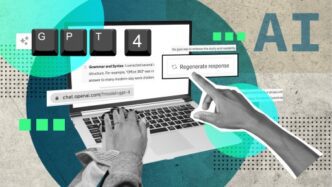Artificial intelligence is no longer confined to giant cloud servers or tech giant platforms. A new trend is emerging—AI is going local. Local large language models (LLMs), the same tools behind smart chatbots and AI-powered writing assistants, are now running directly on personal devices. And this shift is doing more than just democratizing access—it’s redefining what privacy in the age of AI truly means.
Instead of relying on remote servers, users can now access models as powerful as GPT-4.5 locally. That means you can write code, generate content, or summarize documents—all without sending a single request to the cloud. Your data stays with you. No logs, no server-side storage, no monetization.
Why the Local AI Movement Is Gaining Momentum
For years, if you wanted access to powerful AI tools, you had to go through major platforms like OpenAI, Google, or Anthropic. These platforms worked well for scalability and convenience but introduced privacy risks, latency, and limitations on use.
Then came the rise of open-source AI. Organizations such as Hugging Face, Stability AI, EleutherAI, and Meta released models like LLaMA, Mistral, and Phi under permissive licenses. These models can now be downloaded, fine-tuned, and run directly on consumer-grade devices thanks to tools like llama.cpp and Ollama.
Meanwhile, Apple’s M-series chips and affordable high-end GPUs made it possible for hobbyists, researchers, and privacy advocates to run 7B, 13B, or even 70B parameter models from their own desktops.
The Privacy Power Shift of Local LLMs
Local LLMs are changing the rules of digital privacy. When you use a cloud-based model, your prompts are transmitted across the web, stored temporarily—or sometimes longer—and potentially analyzed. Even if the provider promises not to store them, users still have to trust that claim.
By contrast, running models locally keeps everything on your machine. No data leaves your system. For professionals like journalists, lawyers, or therapists, that’s a game-changer. They can now use AI without compromising sensitive information.
And for others, it’s about peace of mind. When you control the model and the environment, you don’t have to worry about backend logging, surveillance, or data mining. You stay in charge.
Real-World Uses: How People Are Leveraging Local LLMs
Local LLMs aren’t just tech experiments—they’re being used every day across different sectors. Here’s how they’re making an impact:
- Content Creation: Writers can work on drafts, campaigns, or confidential strategies without risking leaks to third-party platforms.
- Software Development: Developers can safely test functions, refactor code, or detect bugs without exposing proprietary systems or internal logic.
- Language Learning: Learners can simulate conversations, get grammar feedback, or translate nuanced expressions without risking exposure to language tracking algorithms.
- Personal Productivity: From summarizing confidential documents to drafting client emails, local models help users stay efficient while safeguarding data.
Some users are even customizing entire workflows—chaining voice input, document processing, and visualization tools together. These personalized setups are only possible when AI lives on your machine.
But Local LLMs Aren’t Without Challenges
Despite their benefits, local models do come with trade-offs. Running a 13B+ model requires serious hardware. While model compression helps, not all laptops can manage it smoothly.
Maintenance is another hurdle. Unlike plug-and-play cloud tools, local models need manual updates, tuning, and integration. For instance, an insurance provider using a local model to offer car or van coverage would need to input all market data manually.
Performance is another issue. Local inference is often slower than API-based responses from cloud-hosted models. So for users prioritizing speed or handling massive data volumes, cloud AI still wins.
However, things are changing fast. Optimizations like quantized 4-bit or 8-bit models, coupled with smarter architectures, are bridging the performance gap. And as hardware improves, local models will become more accessible to everyone.
Why Local LLMs Matter on a Global Scale
This shift toward local AI isn’t just about privacy—it’s about reclaiming control. It’s part of a broader decentralization trend. Users, especially in countries with strict privacy rules or limited internet infrastructure, are regaining sovereignty over their data and tools.
Local LLMs also help level the playing field. Many startups, schools, or independent developers can’t afford expensive cloud subscriptions. Now, they can build, test, and deploy powerful AI without gatekeepers. From secure banking systems to tamper-proof social media platforms, the possibilities are endless.
Of course, not everything can move off the cloud. Enterprise-scale tools, real-time collaboration, and complex infrastructure still benefit from centralized AI. But users now have a real choice: keep data private or prioritize convenience.
The Future Is Personal: AI on Your Terms
We’re only scratching the surface of what local LLMs can do. Developer communities are thriving, open-source innovation is exploding, and even chipmakers are optimizing for AI workloads.
Some startups are now designing hybrid systems that run locally but sync with the cloud only when necessary. Others are going all-in, creating entire ecosystems around local inference.
This isn’t just a technical trend—it’s a shift in how we relate to AI. With local models, you don’t have to give up your autonomy for intelligence. You don’t have to trade privacy for productivity. The future of AI isn’t locked in a server farm—it’s sitting on your desk.













